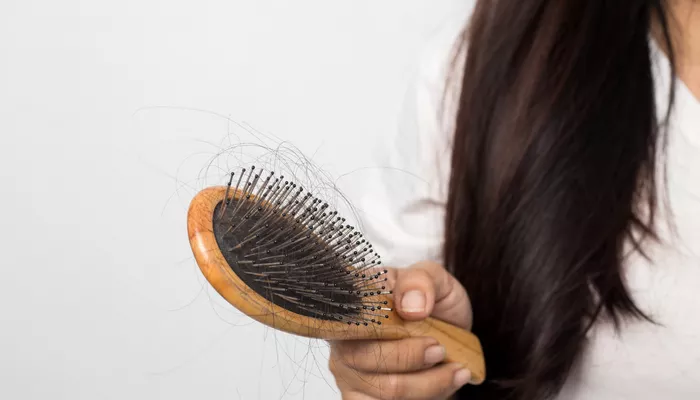Hair loss is a common concern for many people, and you might have noticed that your hair seems to shed more during certain times of the year. If you’ve ever asked, “Why is my hair falling out so much this month?” you’re not alone. Research and anecdotal evidence suggest that hair loss can follow seasonal patterns. In this article, we’ll explore which month hair falls out the most, why this happens, and what you can do to care for your hair during these periods. Let’s dive in!
The Hair Growth Cycle: A Quick Overview
To understand seasonal hair loss, it’s important to know how hair grows.
Hair goes through three main phases:
- Anagen Phase (Growth Phase): This phase lasts 2–7 years. Hair actively grows during this time.
- Catagen Phase (Transition Phase): A short 1–2 week phase where hair stops growing and detaches from its blood supply.
- Telogen Phase (Resting Phase): Hair rests for 2–4 months before falling out. About 10–15% of your hair is in this phase at any time.
After the telogen phase, hair sheds, and new hair begins to grow. On average, losing 50–100 hairs per day is normal. However, during certain months, shedding can increase due to seasonal triggers.
Seasonal Hair Loss Patterns
Hair shedding often follows seasonal trends linked to environmental changes, hormones, and lifestyle factors.
Let’s break it down by season:
Spring (March–May)
Spring is a time of renewal, but your hair might not follow suit. After winter stress (cold weather, dry indoor heating), some people notice increased shedding in early spring. However, studies show spring is not the peak shedding season. Instead, hair often enters the telogen phase during spring, setting the stage for later loss.
Summer (June–August)
Summer brings sun, heat, and outdoor activities.
While hair loss isn’t at its peak here, summer habits can trigger future shedding:
- UV Exposure: Sun damage weakens hair.
- Chlorine/Saltwater: Swimming can dry out hair, causing breakage.
- Heat and Sweat: Scalp irritation may disrupt hair health.
By late summer, more hairs enter the telogen phase, preparing to shed in the following months.
Fall (September–November)
This is the peak season for hair loss. Studies, including one published in the British Journal of Dermatology, found that people experience the highest percentage of hairs in the telogen phase during July, leading to noticeable shedding 2–4 months later—peaking in October or November.
- Why Fall? Evolutionary biologists suggest humans may retain a “molt” pattern from animal ancestors who shed fur seasonally.
- Daylight Changes: Shorter days reduce melatonin production, affecting hair growth cycles.
Winter (December–February)
Cold weather and dry air can make hair brittle, but shedding typically slows by winter. However, holiday stress or diet changes (e.g., sugary treats, less hydration) may cause telogen effluvium (stress-induced shedding), which appears 2–3 months later.
Why Does Hair Fall Out More in Fall?
The autumn spike in shedding is linked to several factors:
- Summer Stressors: UV exposure, dehydration, and chemical damage (e.g., chlorine) weaken hair over summer, pushing it into the telogen phase.
- Hormonal Shifts: Reduced sunlight in fall alters melatonin and cortisol levels, disrupting hair growth.
- Evolutionary Traces: Like animals shedding coats, humans may shed more hair post-summer to prepare for colder months.
Other Factors That Worsen Seasonal Shedding
While fall is the peak month, these factors can amplify hair loss:
- Stress: Holiday pressures, work deadlines, or major life events trigger cortisol spikes, forcing hair into the telogen phase.
- Diet Changes: Crash diets, holiday overeating, or nutrient deficiencies (iron, zinc, vitamin D) weaken hair.
- Weather Extremes: Dry winter air or summer humidity disrupts scalp health.
- Hormonal Fluctuations: Postpartum, menopause, or thyroid issues can align with seasonal shedding.
How to Protect Your Hair During Peak Shedding Months
As a hairstylist, here’s my advice to clients for managing seasonal hair loss:
Adjust Your Hair Care Routine
- Gentle Washing: Use sulfate-free shampoos to avoid stripping natural oils.
- Deep Conditioning: Weekly masks repair summer damage and strengthen hair.
- Limit Heat Tools: Air-dry hair when possible, and use heat protectant sprays.
Boost Nutrition
- Protein-Rich Foods: Eggs, fish, and nuts support keratin production.
- Vitamins A, C, D, E: Promote scalp health and collagen production.
- Stay Hydrated: Dehydration makes hair brittle.
Manage Stress
- Sleep 7–8 Hours: Hair repairs itself during sleep.
- Yoga/Meditation: Reduces cortisol levels.
Protect Hair from the Elements
- Summer: Wear hats or UV-protectant sprays.
- Winter: Use moisturizing oils and avoid tight hats that cause breakage.
When to See a Doctor
Seasonal shedding should ease within 2–3 months. Consult a dermatologist if:
- You lose clumps of hair or notice bald patches.
- Shedding lasts longer than 6 months.
- You have itching, redness, or scalp pain.
Conditions like alopecia, thyroid disorders, or iron deficiency may mimic seasonal shedding.
Conclusion
While hair loss can feel alarming, it’s often a natural response to seasonal changes. October and November are typically the peak months for shedding, largely due to summer stressors and biological rhythms. By understanding your hair’s needs and adjusting your care routine, you can minimize excess loss and keep your locks healthy year-round.
Related topics:
Why Does My Hair Fall Out When I Lose Weight?
Why Does My Hair Fall Out Easily? A Full Analysis
Is Stress Hair Loss Temporary?


